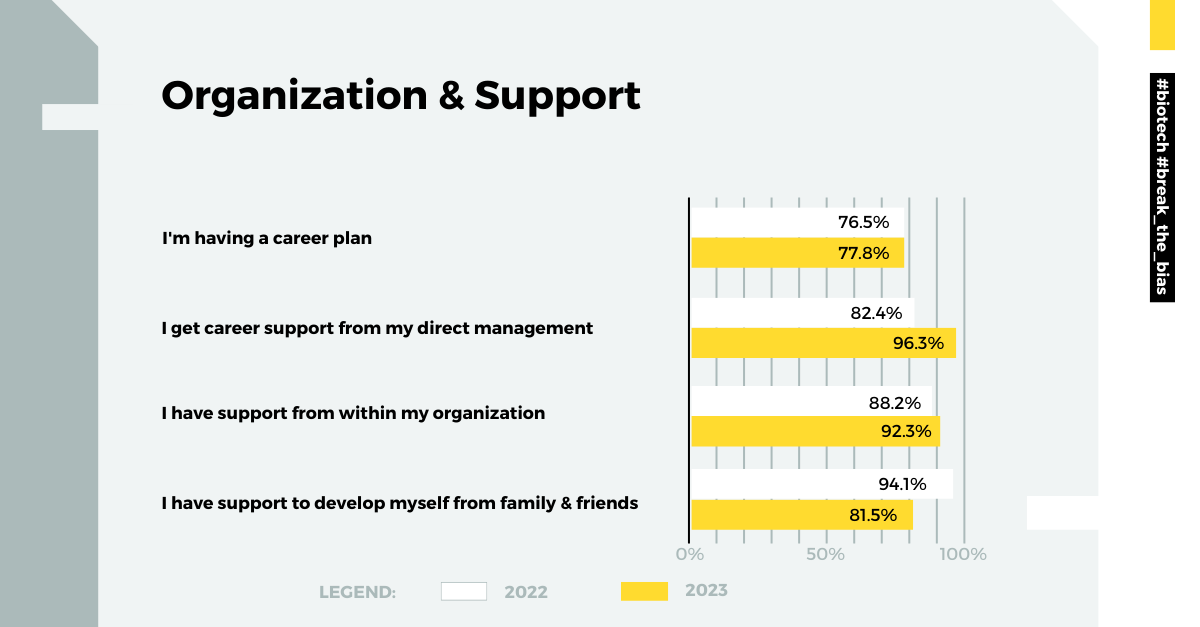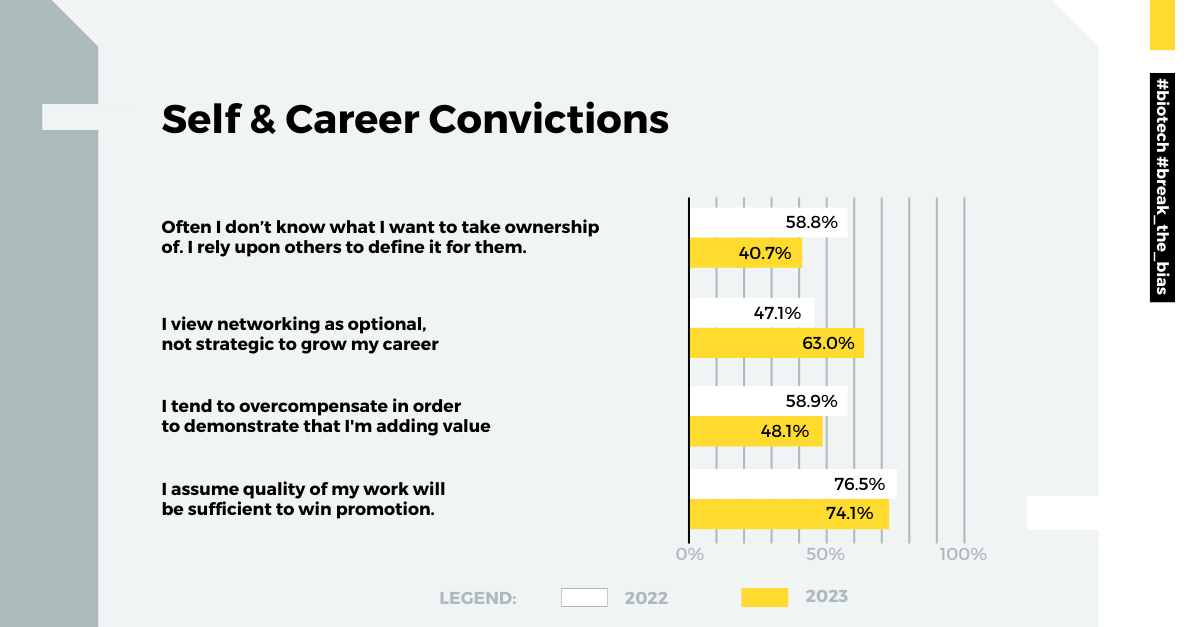10 min read

One year ago, we surveyed women at A4BEE to learn what hinders them from reaching their full potential. You can read the results in this article. This year, we also collected women’s responses and checked what has changed.
Why is it valuable to ask women how they feel in the workplace?
Asking women for feedback and actively working to address any issues they raise can be beneficial for the organization as a whole. Based on the answers, we can make positive changes and create a more inclusive work environment. We believe it can lead to better collaboration, higher employee satisfaction, and increased productivity.
Besides, despite the actions for women, we still experience inequalities in the labour market in Europe and worldwide:
- Women earn less than men for the same job. The average gender pay gap in the EU is 12.7% (as of 2021) [1]
- Women are underrepresented as managers and leaders [2]
- Women leaders are more likely to report that characteristics like gender or being a parent played a role in being denied or overlooked for a raise or promotion [3]
Once we know the inequalities, we can begin to overcome them.
Survey Background
In 2022 the survey was answered by 17 women from A4BEE, compared to 27 in 2023. While in 2022, it was 100% of women, this year, answers were provided by 71 % of them.
Results
Do women have support within an organization?

- I’m having a career plan – 76.5% vs 77.8%
- I get support from my direct management – 82.4% vs 96.3%
- I have support from within my organization – 88.2% vs 92.3%
- I have support to develop myself from family and friends – 94.1% vs 81.5%
Through this section, we wanted to see how the organization supports women’s career development. In all areas concerning the organization, we noted a slight improvement compared to 2022. This may be because, as a company, we modify career development tools yearly, such as the self-skills assessment, and run programs for People Managers to be supportive leaders.
How do women view themselves?

- I lack of confidence and self-belief – 70.6% vs 66.7%
- I tend to question myself and doubt my worthiness – 88.2% vs 81.5%
- I’m often uncomfortable talking about myself and what I bring to the table. I must learn to articulate my strengths and take charge of my own personal brands – 100% vs 77.8%
- I’m generally easy about asking for what I want. I have courage to stand up and ask for what I want – 35.3% vs 59.3%
When it comes to confidence, self-belief, branding and presence, and making the “ask”, we can see clear improvements, but still, there is space to act on issues like self-confidence and believing in one’s value. Women also highlight they need to learn to articulate their strengths and have the drive to develop in this area. Even though many women at A4BEE are leaders, provide training or speak at conferences, generally there is still lack of confidence and self-belief.
To explain this, we can refer to the “confidence gap” phenomenon. There is a difference between men and women regarding self-confidence and self-assessment of skills and abilities. Women tend to underestimate their abilities and attribute their success to external factors. So even if they act well, sometimes it doesn’t correspond with their self-perception. [4]
The education and support is needed. In the following part of this article we share the ideas, how we can change the situation.
Other factors

- Often I don’t know what I want to take ownership of. I rely upon others to define it for them – 58.8% vs 40.7%
- I view networking as optional, not strategic to grow my career – 47.1% vs 63%
- I tend to overcompensate in order to demonstrate that I’m adding value – 58.9% vs 48.1%
- I assume quality of my work will be sufficient to win promotion – 76.5% vs 74.1%
In the three domains above, we can observe improvements. Most women are decisive and confident in their career development, as they know what they want to take ownership of. They also see the importance of networking to gain professional contacts. And this is not only a declaration because we have women attending conferences and events, showing their activity. Women also see the good quality of their job, as they assume it will be sufficient to promote.
But, what is concerning, almost half of the women assume they need to prove their value as an employee. We can focus on reliable feedback to ensure they do a good job and add value to the company.
Which areas are worth focusing on?
In addition to diagnosing career-related areas among women, through the survey, we also wanted to find out what changes women need. The answers to the following question are about work at A4BEE and women’s experiences in general. Therefore, they can inspire other companies and individuals who want to support women. The question is: What is one main issue that needs to be changed, so more women can reach their full potential?
Below, we describe the main areas indicated by women in order from most to least frequently mentioned, accompanied by thought-provoking quotes from the answers.
Women’s Mindset
Women can work on overcoming fears and self-doubt, developing self-confidence, and recognizing the value of their work. Deciding to pursue personal growth and seeking help and support when needed are crucial mindset elements. Building confidence and self-belief can be achieved through coaching or training, which open up new opportunities for personal and professional growth.
Working on their mindset is something every woman can do and show themselves that improving their situation is possible.
However, women should not be required to deal with stereotypes and inequalities alone. Educational, cultural, and organizational support is needed to spread the burden of change across society rather than individuals, helping to create long-term transformation.
The following points relate to issues that we can all reflect on — regardless of our gender or position.
Support from organization
Employers should promote work-life balance, flexibility in working hours, and remote work whenever it’s possible. It especially gives women a chance to combine work and personal responsibilities because they more often care for children or the elderly. Besides, “organizations need to provide equal opportunities for women to access training, development, and leadership programs”. Ensuring equal treatment regardless of gender fosters a supportive work environment.
Education and training
Early education for girls can help them understand that their gender is not an obstacle. Essential is “teaching girls that their roles are not so much connected to being a female, but still — they can take a lot of their gender. Many great assets connected to being a woman aren’t communicated in public. As the ability to focus on many tasks, perseverance, efficiency, or mindfulness.”
When girls learn their gender does not define them, they are empowered to reach their full potential. Then, women are more likely to pursue and succeed in also traditionally male-dominated fields. Additionally, in the organization, we can train women to strengthen courage and self-confidence using workshops or coaching.
Breaking gender stereotypes
Gender stereotypes should be overcome from early education to prevent women from being undervalued at work and in society. “The expectation that girls are supposed to be more polite and quiet (…) can be harmful, as it can pressure girls and women to prioritize being polite over expressing their opinions and needs”. It is crucial to support women in choosing their paths, even when they are non-standard. And we should remember that gender stereotypes can also touch men.
Appreciate women and their strengths
Respect from co-workers and superiors, feedback, and highlighting strengths confirm that work is important and has meaning. It helps women to improve their work and develop. Actions like these can also answer the problem of self-confidence and talking about one’s skills.
Trust in women
Women need an environment where their skills are believed in. Sometimes “there is a lack of trust to woman, to let man believe that woman can sometimes do better than a man.” Creating a culture of trust and respect can benefit all employees and help to foster a more positive and productive work environment. It is essential in STEM, where there is more challenging for women to succeed in their job because people tend to think that women aren’t appropriate for the technical role and are more likely to choose a man or ask him for help. [5]
Support from a partner in raising children
Women are overwhelmed by domestic responsibilities. According to the “European Working Conditions Survey” from 2015, women in Europe at all ages spend more time doing unpaid work than men, while men do more paying jobs. But generally, when we combine the number of hours per week, women work more: 55 hours compared to 49. Unpaid work is, e.g., domestic tasks like cleaning, cooking, and caring for children or the elderly. Regarding couples with a child, the disparity between men and women is even more significant. [6]
Sometimes domestic responsibilities block women from personal and professional development and working full time.
Mothers as role models
Young girls first learn from their parents, so being confident, and believing in herself mother is the first step to building child’s strengths. In addition, a safe and supportive atmosphere in the family and reinforcing the girl’s strengths will help her in the future to act, develop and use advantages in her personal and professional life. And remember the boys who, seeing the example of a strong and wise mother, will be more likely to treat the women they meet in later life in this way.
Is there a difference in women’s perceptions of this issue since 2022?
When we compare the results to the last year, we can see that still the most important thing is women’s mindset and self-perception. It’s the areas where women on their own can work when they realize this issue. It is also a work for all society — men too — to support women’s confidence, showing they are valuable and have a wide range of strengths.
Whereas one year ago, women highlighted the importance of gender equity in the case of salaries and looking at their competencies, this year, they indicated providing equal opportunities to women and men in their development within the organization. They also took into consideration basic gender stereotypes, which still exist and have an impact on both young girls and adult women.
Limitations and recommendations
It is worth considering that the survey was conducted in one Polish company on a relatively small sample. Additionally, in 2022, the number of women in the company was significantly lower, so the dynamic changes were not indifferent to the survey results.
The reality in other organizations may look very different, so if you are interested in looking at the barriers and difficulties of your employees, we recommend doing a similar survey and tailoring the items to your own needs. It is also important to remember that cultural factors can influence women’s behaviors and perceptions so that the results may differ significantly in other parts of the world.
What’s next?
Let’s be inspired by women’s ideas for dealing with difficulties. Once we have diagnosed the greatest challenges, we can turn our attention to areas of particular importance to our women… and take initiatives to support women in our company!
Then, we want to measure changes in the following years and modify our approach. We also consider surveying men to have a reference point and find out their situation because we don’t forget their challenges and needs.
Awareness of difficulties is of great importance and can help to change attitudes and contribute to the growth of both the supporters and the supported.
References
[2], [3] Women in management
[5] Women and Men in STEM Often at Odds Over Workplace Equity
[6] 6th European Working Conditions Survey
The article is based on the results of the survey conducted by Karolina Marzantowicz






